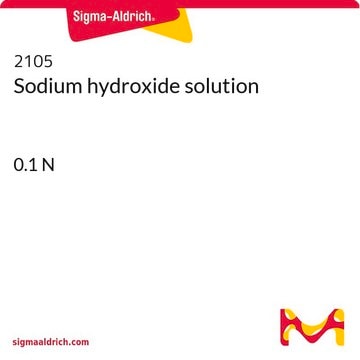1.09139
Hydroxyde de sodium solution
c(NaOH) = 0.25 mol/l (0.25 N), ready-to-use volumetric solution for titration, Titriplex®
About This Item
Produits recommandés
product name
Hydroxyde de sodium solution, c(NaOH) = 0.25 mol/l (0.25 N), Titripur®
Pression de vapeur
3 mmHg ( 37 °C)
Niveau de qualité
Gamme de produits
Titripur®
Forme
liquid
Qualité
Analyzed in our ISO 17025 accredited QC lab
Capacité de réaction
reaction type: Acid-base reactions
Conditionnement
Titripac® of
Concentration
0.25 M
Technique(s)
titration: suitable
pH
13.5 (20 °C in H2O)
Densité
1.01 g/cm3 at 20 °C
Température de stockage
15-25°C
Chaîne SMILES
[OH-].[Na+]
InChI
1S/Na.H2O/h;1H2/q+1;/p-1
Clé InChI
HEMHJVSKTPXQMS-UHFFFAOYSA-M
Vous recherchez des produits similaires ? Visite Guide de comparaison des produits
Application
- Adsorption Studies: Sodium hydroxide solution is used in treating polymer adsorbents to enhance their adsorption properties. A recent study investigated the effect of treating a PVC/Aliquat-336 polymer adsorbent with sodium hydroxide on chromium (VI) adsorption. The treatment improved the adsorption capacity of the polymer, making it more effective in removing heavy metals from aqueous solutions (Ouazine et al., International Journal of Environmental Analytical Chemistry, 2022).
- Synthesis of Sodium Ethoxide: Sodium hydroxide solution is employed in the synthesis of sodium ethoxide, an important reagent in organic synthesis. Research has demonstrated that sodium ethoxide can be synthesized efficiently at ambient temperature using sodium hydroxide and ethanol-90. This method offers a straightforward and cost-effective approach for preparing this key chemical intermediate (Randriana et al., World Journal of Applied Chemistry, 2021).
- Corrosion Inhibition: Sodium hydroxide solution is used in corrosion inhibition studies. Research has shown that an aqueous extract of Thespesia populnea plant leaves can effectively inhibit the corrosion of aluminum steel in sodium hydroxide solution. The study utilized electrochemical techniques to demonstrate the formation of a protective film on the steel surface, highlighting the potential of natural inhibitors in industrial applications (Brindha and Venkatraman, Research Journal of Chemistry and Environment, 2023).
Caractéristiques et avantages
This volumetric solution is analyzed by our calibration laboratory D-K-15185-01-00 which is accredited according to DIN EN ISO/IEC 17025 for analysis of amount-of-substance concentrations in volumetric solutions by DAkkS (Deutsche Akkreditierungsstelle - German National Accreditation Body). The accreditation certificate can be found at www.sigmaaldrich.com/ISO17025.
Conditionnement
Titripac® packaging - all SKU-pack size numbers ending "4000, 4003, 9010, 9013" - more information on www.sigmaaldrich.com/Titripac
Remarque sur l'analyse
Amount-of-substance concentration 0.24875 - 0.25125 mol/L
Measurement uncertainty ± 0.00075 mol/L
Traceability NIST SRM
The concentration is determined by volumetric titration and refers to 20°C.
The amount-of-substance concentration of this volumetric solution is traceable to a primary standard reference material (SRM) from the National Institute of Standards and Technology, Gaithersburg, USA (NIST SRM 84 potassium hydrogen phthalate) by means of volumetric standard potassium hydrogen phthalate (article number 1.02400), certified reference material according to ISO 17034, analyzed by our accredited calibration laboratory of Merck KGaA, Darmstadt, Germany according to DIN EN ISO/IEC 17025. The uncertainty is expressed as expanded measurement uncertainty with a coverage factor k=2 covering a confidence level of 95%.
Note: The titer is a correction factor to correct for variations of the volumetric solution, the titration equipment, the temperature and other laboratory conditions. For correct titration results it is recommended to determine a titer with the laboratory specific equipment and under laboratory specific conditions directly after opening a new bottle and at regular time intervals.
Informations légales
Produit(s) apparenté(s)
Mention d'avertissement
Warning
Mentions de danger
Conseils de prudence
Classification des risques
Eye Irrit. 2 - Met. Corr. 1 - Skin Irrit. 2
Code de la classe de stockage
8B - Non-combustible, corrosive hazardous materials
Classe de danger pour l'eau (WGK)
nwg
Point d'éclair (°F)
Not applicable
Point d'éclair (°C)
Not applicable
Certificats d'analyse (COA)
Recherchez un Certificats d'analyse (COA) en saisissant le numéro de lot du produit. Les numéros de lot figurent sur l'étiquette du produit après les mots "Lot" ou "Batch".
Déjà en possession de ce produit ?
Retrouvez la documentation relative aux produits que vous avez récemment achetés dans la Bibliothèque de documents.
Les clients ont également consulté
Notre équipe de scientifiques dispose d'une expérience dans tous les secteurs de la recherche, notamment en sciences de la vie, science des matériaux, synthèse chimique, chromatographie, analyse et dans de nombreux autres domaines..
Contacter notre Service technique



